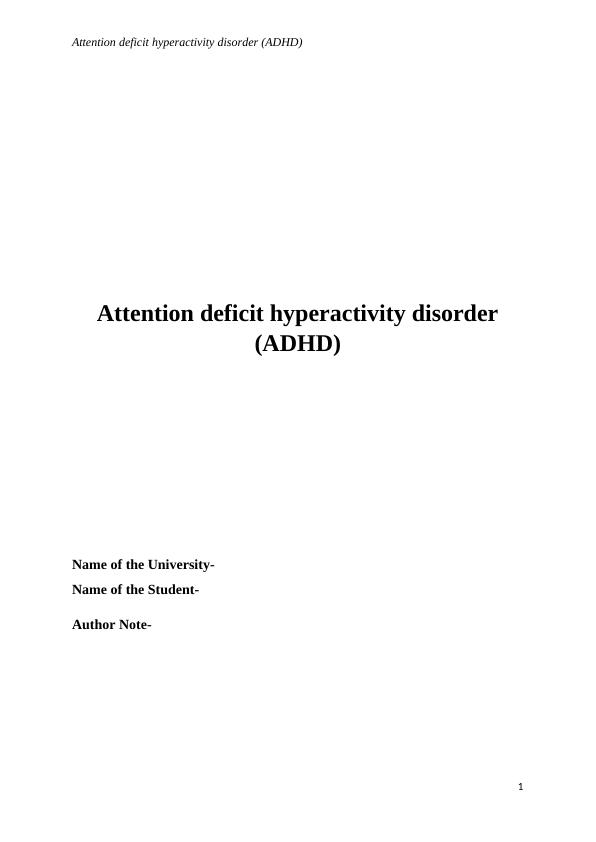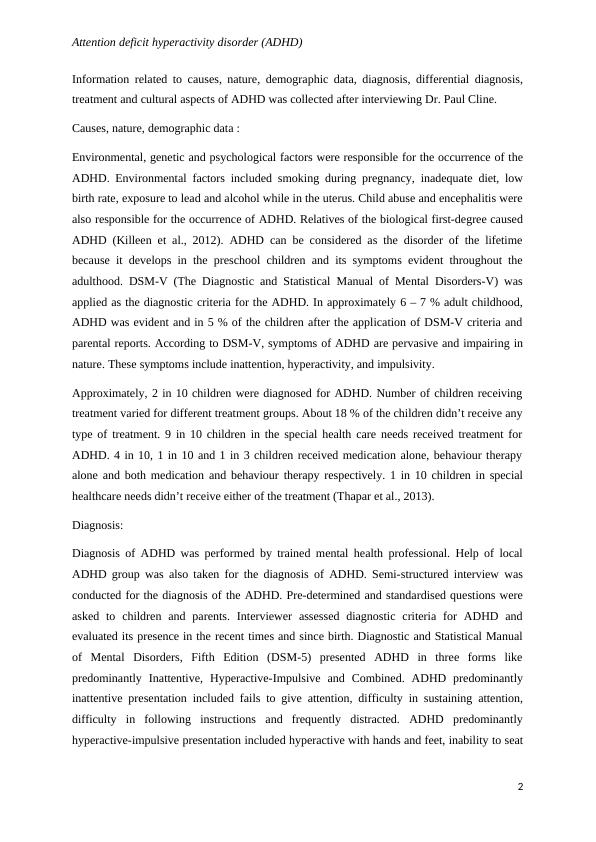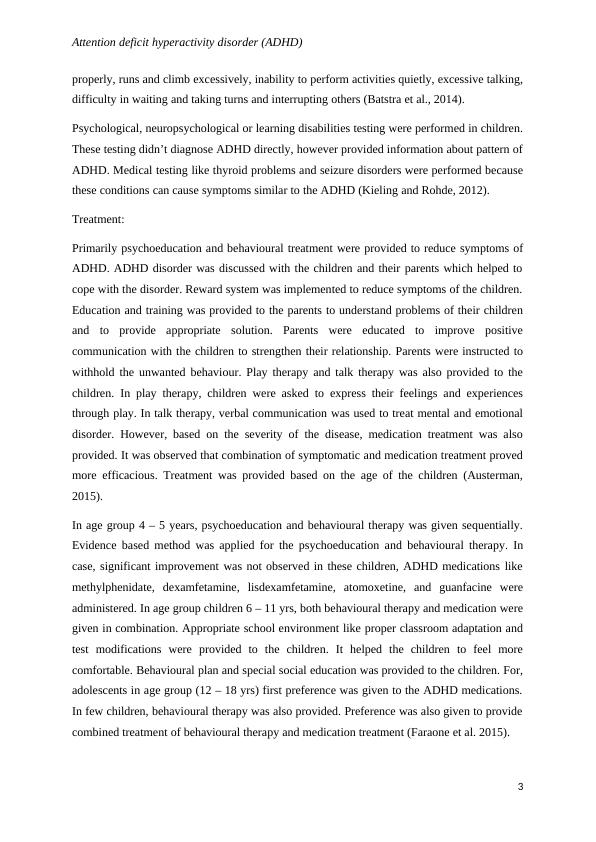Attention deficit hyperactivity disorder - Assignment PDF
9 Pages2693 Words60 Views
Added on 2021-04-21
Attention deficit hyperactivity disorder - Assignment PDF
Added on 2021-04-21
ShareRelated Documents
Attention deficit hyperactivity disorder (ADHD)Attention deficit hyperactivity disorder(ADHD)Name of the University- Name of the Student- Author Note-1

Attention deficit hyperactivity disorder (ADHD)Information related to causes, nature, demographic data, diagnosis, differential diagnosis,treatment and cultural aspects of ADHD was collected after interviewing Dr. Paul Cline.Causes, nature, demographic data :Environmental, genetic and psychological factors were responsible for the occurrence of theADHD. Environmental factors included smoking during pregnancy, inadequate diet, lowbirth rate, exposure to lead and alcohol while in the uterus. Child abuse and encephalitis werealso responsible for the occurrence of ADHD. Relatives of the biological first-degree causedADHD (Killeen et al., 2012). ADHD can be considered as the disorder of the lifetimebecause it develops in the preschool children and its symptoms evident throughout theadulthood. DSM-V (The Diagnostic and Statistical Manual of Mental Disorders-V) wasapplied as the diagnostic criteria for the ADHD. In approximately 6 – 7 % adult childhood,ADHD was evident and in 5 % of the children after the application of DSM-V criteria andparental reports. According to DSM-V, symptoms of ADHD are pervasive and impairing innature. These symptoms include inattention, hyperactivity, and impulsivity. Approximately, 2 in 10 children were diagnosed for ADHD. Number of children receivingtreatment varied for different treatment groups. About 18 % of the children didn’t receive anytype of treatment. 9 in 10 children in the special health care needs received treatment forADHD. 4 in 10, 1 in 10 and 1 in 3 children received medication alone, behaviour therapyalone and both medication and behaviour therapy respectively. 1 in 10 children in specialhealthcare needs didn’t receive either of the treatment (Thapar et al., 2013). Diagnosis:Diagnosis of ADHD was performed by trained mental health professional. Help of localADHD group was also taken for the diagnosis of ADHD. Semi-structured interview wasconducted for the diagnosis of the ADHD. Pre-determined and standardised questions wereasked to children and parents. Interviewer assessed diagnostic criteria for ADHD andevaluated its presence in the recent times and since birth. Diagnostic and Statistical Manualof Mental Disorders, Fifth Edition (DSM-5) presented ADHD in three forms likepredominantly Inattentive, Hyperactive-Impulsive and Combined. ADHD predominantlyinattentive presentation included fails to give attention, difficulty in sustaining attention,difficulty in following instructions and frequently distracted. ADHD predominantlyhyperactive-impulsive presentation included hyperactive with hands and feet, inability to seat2

Attention deficit hyperactivity disorder (ADHD)properly, runs and climb excessively, inability to perform activities quietly, excessive talking,difficulty in waiting and taking turns and interrupting others (Batstra et al., 2014). Psychological, neuropsychological or learning disabilities testing were performed in children.These testing didn’t diagnose ADHD directly, however provided information about pattern ofADHD. Medical testing like thyroid problems and seizure disorders were performed becausethese conditions can cause symptoms similar to the ADHD (Kieling and Rohde, 2012).Treatment:Primarily psychoeducation and behavioural treatment were provided to reduce symptoms ofADHD. ADHD disorder was discussed with the children and their parents which helped tocope with the disorder. Reward system was implemented to reduce symptoms of the children.Education and training was provided to the parents to understand problems of their childrenand to provide appropriate solution. Parents were educated to improve positivecommunication with the children to strengthen their relationship. Parents were instructed towithhold the unwanted behaviour. Play therapy and talk therapy was also provided to thechildren. In play therapy, children were asked to express their feelings and experiencesthrough play. In talk therapy, verbal communication was used to treat mental and emotionaldisorder. However, based on the severity of the disease, medication treatment was alsoprovided. It was observed that combination of symptomatic and medication treatment provedmore efficacious. Treatment was provided based on the age of the children (Austerman,2015). In age group 4 – 5 years, psychoeducation and behavioural therapy was given sequentially.Evidence based method was applied for the psychoeducation and behavioural therapy. Incase, significant improvement was not observed in these children, ADHD medications likemethylphenidate, dexamfetamine, lisdexamfetamine, atomoxetine, and guanfacine wereadministered. In age group children 6 – 11 yrs, both behavioural therapy and medication weregiven in combination. Appropriate school environment like proper classroom adaptation andtest modifications were provided to the children. It helped the children to feel morecomfortable. Behavioural plan and special social education was provided to the children. For,adolescents in age group (12 – 18 yrs) first preference was given to the ADHD medications.In few children, behavioural therapy was also provided. Preference was also given to providecombined treatment of behavioural therapy and medication treatment (Faraone et al. 2015). 3

End of preview
Want to access all the pages? Upload your documents or become a member.
Related Documents
Attention Deficit Hyperactivity Disorder: Symptoms, Diagnosis, and MFT Therapylg...
|14
|3912
|189
Attention Deficit Hyperactivity Disorder1lg...
|15
|4094
|15
Public Health Assignment (Doc)lg...
|13
|3381
|99
Attention Deficit Hyperactive Disorder Reportlg...
|16
|4352
|16
(PDF) Attention Deficit Hyperactivity Disorder (ADHD)lg...
|8
|1600
|37
Interview analysis Assignment PDFlg...
|10
|2881
|45
